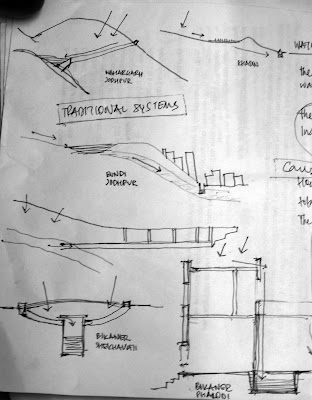i got back on my cycle today, '98 is the last time i can remember riding it. nice sleek street bike, bsa mach 1. a decade of lying on my mom's landing, and it cost me just 600 bucks to get it back on the road . . . its going to take a bit more to get me into shape though, i damn near passed out by the time i reached vasant kunj from yusuf sarai!
well the plan is to do some mountain biking . . . lets see how far that goes, but i think a week of early morning rides is definately in order, its a nightmare otherwise, in the day i mean to ride a cycle!
Wednesday, July 23, 2008
Tuesday, July 22, 2008
TWS's
o ‘Bavdis’, ‘Jhalaras’ and ‘Khadins’ fed by artificial shallow aquifers in Rajasthan
o ‘Karez’ or ‘Quanat’ system of tapping distant aquifers in Quetta, Baluchistan
o ‘Kuis’ ‘kunds’ and the par system of Rajasthan and Gujarat
o ‘Eris’ and ‘oornis’ rainwater harvesting tanks in Tamilnadu
o ‘Surangams’, the horizontal wells of Kasargod, Kerala
o Runoff collecting ‘Zabos’ and Indigenous bamboo drip irrigation ‘Cheo-ozihi’ in the North East
o ‘Virdhas’ which isolate potable water in the saline regions of Kutch
o ‘Katas’, ‘Mundas’ used by the Gond tribes to maximize the use of the annual monsoon
o Roof top rain water harvesting of ‘palar pani’ in havelis and temples
o Interconnected rainwater tank systems in Mandu and Chittaurgarh forts
o ‘Karez’ or ‘Quanat’ system of tapping distant aquifers in Quetta, Baluchistan
o ‘Kuis’ ‘kunds’ and the par system of Rajasthan and Gujarat
o ‘Eris’ and ‘oornis’ rainwater harvesting tanks in Tamilnadu
o ‘Surangams’, the horizontal wells of Kasargod, Kerala
o Runoff collecting ‘Zabos’ and Indigenous bamboo drip irrigation ‘Cheo-ozihi’ in the North East
o ‘Virdhas’ which isolate potable water in the saline regions of Kutch
o ‘Katas’, ‘Mundas’ used by the Gond tribes to maximize the use of the annual monsoon
o Roof top rain water harvesting of ‘palar pani’ in havelis and temples
o Interconnected rainwater tank systems in Mandu and Chittaurgarh forts
Friday, July 18, 2008
water
Water is essential for civilization, and has governed the settlement pattern and urban form over the years. The mark of a good Monarch after his defense has got to be his prowess at irrigation. A perennial water supply, bountiful harvest, pleasure palaces (what we would call air con today!) all attributed to this marvelous substance which has enveloped our planet, cushioning it from the big bad universe.
Addressing population in developing cities
Living in the dense metropolises of the day, rapidly growing with scarce if any real planning and in many cases infrastructure. Grids of tube wells puncture the earth, glacial fed rivers have been reduced to toxic wetlands, water is carted around in trucks across our cities at increasing prices. What was available at a road side ghada at the chowk is now in a 10 rupee bottle which is a large constituent of the ever piling landfills. The dreadful condition we have descended to and I say descended because (before we were colonized and presented with a bureaucracy) pre globalisation our cities were quite the model water systems. The Old Delhi railway station was after all built on the Roshnara bagh. Chandni chowk itself had a canal flowing through the centre. I’ll admit the stresses to the environment were negligible in those days, I’m not shunning development either but give a man an inch and he’ll take the mile. Apathy and indifference of the average person is facilitated by a sewage system, piped water and hopefully an stp of some sort. Traditional systems are steadily disappearing most get built over in the urban sprawl, some get pillaged for material others just lie defunct.
Learning from some of the age old systems for maximising the utility of rain water and aquifers alike may not be as far away as it looks today!
Addressing population in developing cities

Living in the dense metropolises of the day, rapidly growing with scarce if any real planning and in many cases infrastructure. Grids of tube wells puncture the earth, glacial fed rivers have been reduced to toxic wetlands, water is carted around in trucks across our cities at increasing prices. What was available at a road side ghada at the chowk is now in a 10 rupee bottle which is a large constituent of the ever piling landfills. The dreadful condition we have descended to and I say descended because (before we were colonized and presented with a bureaucracy) pre globalisation our cities were quite the model water systems. The Old Delhi railway station was after all built on the Roshnara bagh. Chandni chowk itself had a canal flowing through the centre. I’ll admit the stresses to the environment were negligible in those days, I’m not shunning development either but give a man an inch and he’ll take the mile. Apathy and indifference of the average person is facilitated by a sewage system, piped water and hopefully an stp of some sort. Traditional systems are steadily disappearing most get built over in the urban sprawl, some get pillaged for material others just lie defunct.
Learning from some of the age old systems for maximising the utility of rain water and aquifers alike may not be as far away as it looks today!
Tuesday, July 08, 2008
withdrawal
monday 07:30 hrs 070708
one week out of a two year rut, and the shakes are kicking in.
.Delhi
.Orcha
.Jamudi
.Dindori
.Anuppur
.Amarkantak
.Khajuraho
.Delhi
Mahua
one week out of a two year rut, and the shakes are kicking in.
.Delhi
.Orcha
.Jamudi
.Dindori
.Anuppur
.Amarkantak
.Khajuraho
.Delhi
Mahua
Subscribe to:
Posts (Atom)